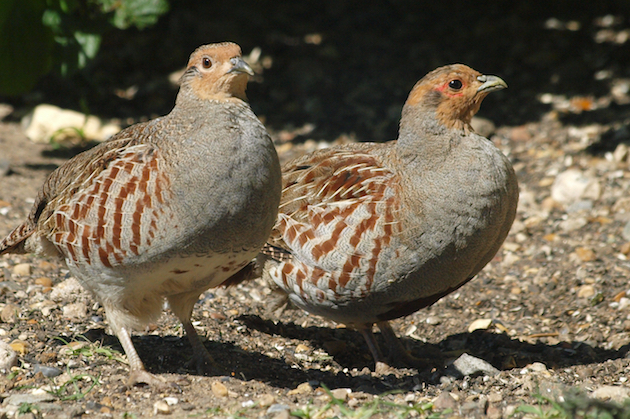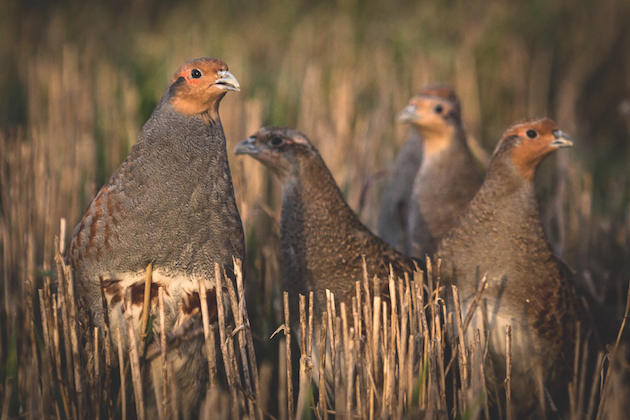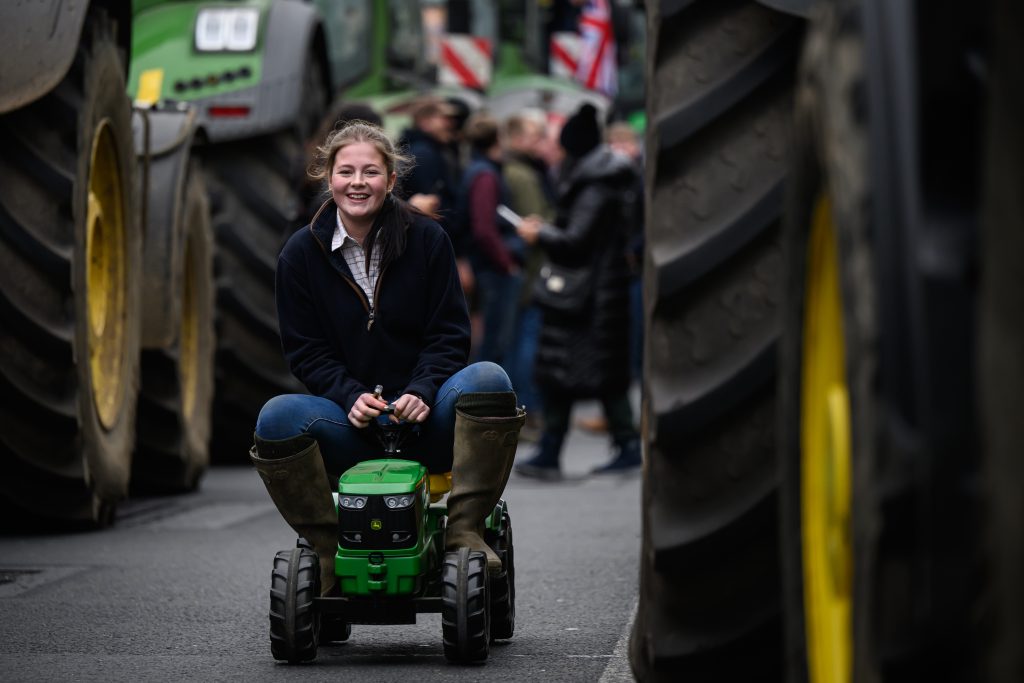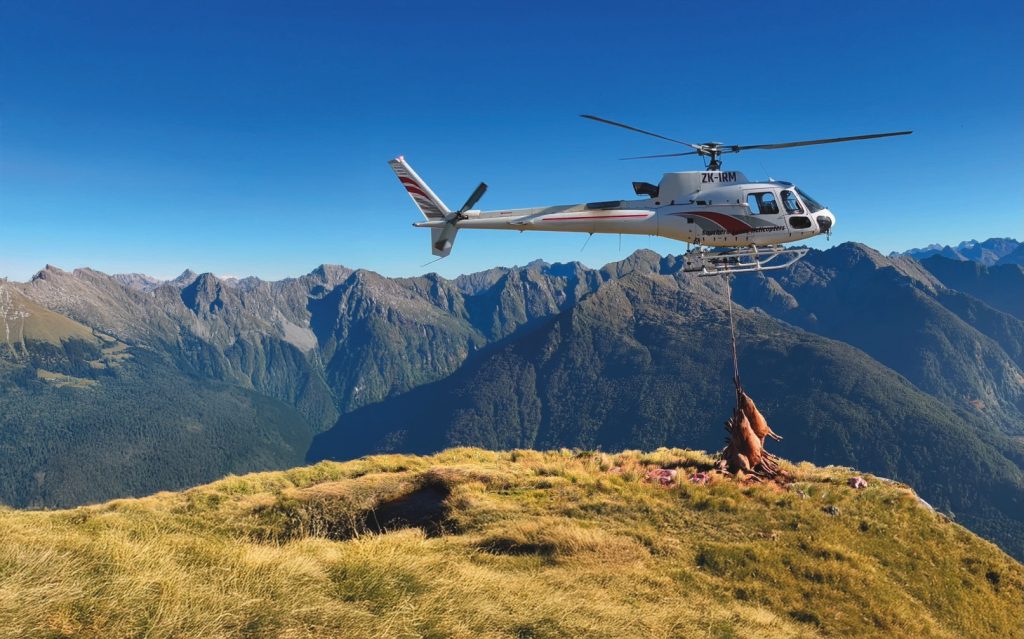Win CENS ProFlex DX5 earplugs worth £1,149 – enter here
A hopeful future for wild partridges
 Panel pic: a confiding pair of grey partridges
Panel pic: a confiding pair of grey partridges
Grey partridges are an addictive and infuriatingly mercurial benchmark of conservation success — or failure. The moment you take an active role in their welfare and the enhancement of their habitat, you have fallen down a rabbit hole.
The brief moments of joy when you see a healthy brood in summer or a covey starburst over the Guns in October are countered by months of despair as they shun your patch and disappear to who knows where.
The grey partridge is like the hedgehog. Both have lived in these isles since time immemorial. Yet neither has successfully adapted to the changes imposed on them by man. While badgers have boomed, foxes found fecundity and pigeons proliferated, the poor old partridge and hedgehog teeter on the brink.
Red-listed
Like a bewhiskered old countryman listening with incredulity to grime music, greys are seemingly unable to get to grips with the 21st century. What does the future hold for grey partridge? Will it remain forever a red-list species? And should it continue to feature on our shoot days?
The GWCT has recently announced that we should be ‘ultra-cautious’ about shooting wild greys this season. A damp June spelled disaster for many broods. Despite the recent admirable upturn in landowners sowing insect-friendly margins and blocks, many areas still show a downturn in the numbers of ‘squishy’ bugs that are essential feeding for grey chicks.
I am fortunate to live in a village that is ringed by grey partridge champions. The farm of Silver Lapwing Award winners Brian and Patrick Barker lies to our north and west. To the south and east, the land so diligently keepered by Adam Steed, winner of the GWCT East Anglian Grey Partridge Award, cups us like a comforting hand.
Both are exemplars of grey partridge conservationism. I asked Adam what measures he is taking to continue his year-on-year increase in wild grey numbers. “Despite the challenges here of moving on to a new stewardship scheme and the Wild Justice-enforced period of cessation in our corvid control, we have managed to stand still with our numbers this year, which is a success,” he said.
There are three factors that people will need to get to grips with. First, with the inexorable rise in raptor numbers, cover margins and blocks must be sown with mixes that provide overhead cover from avian predators. Teasel, chicory, sweet fennel and kale are excellent options. The understorey in these mixes needs to be thinly broadcast. This allows room for chicks to pass through soaked herbage, which lessens the chance of them becoming chilled yet continues to provide plenty of insect food.
Secondly, we need a workable general licence that enables nest predators of vulnerable species to be controlled without bureaucratic application processes.

Some in conservation believe the release of reared greys is detrimental to the wild bird population
Finally, if and when we leave the EU, we must lobby the Government to continue with the excellent environmental schemes that have made large-scale habitat improvement a financial reality. Without such incentives for schemes, the future could be bleak for greys.
Darren Sizer is my mentor and fount of fowling wisdom. He is also a grey partridge fanatic, who produces a fine strain of reared grey partridge that I have used with some success in my efforts at reintroduction.
Some in conservation believe the release of reared greys is detrimental to the wild bird population, a claim that Darren is at pains to decry. “Adding new blood into potentially in-bred strains is a good thing. I wonder just how many greys that are claimed to be ‘wild’ actually are? This year I am working on an experiment similar to the corncrake reintroduction programme that has been successful at Pensthorpe in Norfolk.
“I will be using pairs of greys to hatch and rear their own broods on the rearing field rather than using broody bantams or incubators,” he continued. “The idea is that these will be wilder and better equipped for life when they are released as family groups. I have quite a few customers already asking to try this next spring.
“While providing good habitat is essential for keeping greys, hoping that wild broods will simply find you is not that realistic.”
The benefit of joined-up thinking in grey partridge conservation is becoming a recurring factor in success stories, such as farm clusters. Frequently centred on geographical features — rivers, valleys and so on — they ensure the far-ranging grey is surrounded by friendly neighbours, rather than corralled into oases of suitable habitat.
I am about to embark on two months of hedge-laying on an estate in Essex. It is part of a farm cluster that follows the Dedham Valley and totals 17,000 acres. This landscape-scale thinking takes a huge amount organisation to run effectively. One ‘lead’ farmer is required to steer the group and, as anyone who has served on a parish council will know, the moment you have a committee of more than one, trouble can arise.
However, the GWCT has seen the success of farm clusters through positive returns in its partridge-count scheme. The farm-cluster idea has the approval of Natural England. After Brexit, when the single farm payment looks destined to become a thing of the past, funding for farmers will need to be backed up by demonstrable and meaningful public good for public money.
View this post on Instagram
The farm-cluster model not
only benefits red-listed species, but also soothes the brow of Whitehall bean counters.
I called Dr Roger Draycott, head of research for the GWCT, to get his view on the future for greys. He said he believed an article published in Shooting Times (News, 2 October) may have painted a darker picture than the one that exists.
“I am always an optimist. In some areas, with the right management, greys have had their successes and therefore they can feature in the shooting day. If landowners continue to concentrate upon the key elements of partridge conservation habitat creation and maintenance, predator control and food availability, the future is not so dark.
“However, the potential for decreased or less easily accessible environmental funding for landowners post-Brexit could present huge challenges,” he warned.
“Legal changes also present threats. For example, due to the dramatically reduced amount of over-wintering oil seed rape — largely thanks to the EU ban on neonicotinoids — available cover has been dramatically depleted in the harshest months, leaving greys significantly more vulnerable to raptor predation. To alleviate this, landowners will have to look at growing perennial cover crops or leaving weedy stubbles.”
Reared birds
I asked Roger if he agreed with introducing reared birds.
“If there are fewer than three wild pairs per 100 hectares, there is a good case for introducing either relocated wild pairs or family groups reared in the way that Darren Sizer is trying. Any reintroductions should follow the guidelines produced by the IUCN [International Union for Conservation of Nature].”
I attempted my version of the Euston system — named for the estate on which it was developed — on a mere 20 acres of Suffolk grassland. There are some people who valiantly try to help our most iconic lowland game bird on an even more kitchen-table level. Partridge keeper Paul Hardcastle told me of one couple, totally removed from the shooting world, who reared a clutch in an incubator, grew the poults on in their garden then trickle-released them on to Lea Common on the eastern fringes of London.
Their daily walk routine now includes broadcasting grain in the less busy areas of the common. If they have survived the ravages of dogs and London smog, I know not. However, surely the mantra that to have some greys is better than no greys is admirable?
The grouse, curlew and hen harrier are given near-mythical status by conservationists. The jaunty garden favourite, the robin, was voted Britain’s most popular bird by the general public. The beleaguered grey seems to be overlooked by all bar from a few stalwarts in the shooting and conservation world.
This year it is imperative that all farmers, keepers and landowners participate in the GWCT’s partridge count scheme. The spring count measures breeding abundance and the autumn count measures breeding success.
I urge you to do your bit to ensure that the English grey partridge has a future.
Related Articles
Get the latest news delivered direct to your door
Subscribe to Shooting Times & Country
Discover the ultimate companion for field sports enthusiasts with Shooting Times & Country Magazine, the UK’s leading weekly publication that has been at the forefront of shooting culture since 1882. Subscribers gain access to expert tips, comprehensive gear reviews, seasonal advice and a vibrant community of like-minded shooters.
Save on shop price when you subscribe with weekly issues featuring in-depth articles on gundog training, exclusive member offers and access to the digital back issue library. A Shooting Times & Country subscription is more than a magazine, don’t just read about the countryside; immerse yourself in its most authoritative and engaging publication.







